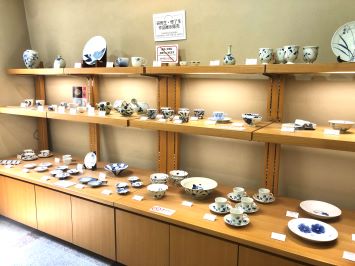



■ご利用案内/Usage guide
| 施設名 Facility name |
瀬戸染付工芸館 Seto Blue and White Ceramics Center |
|---|---|
| 開館時間 Opening hours |
10:00 ~ 17:00(最終入館時間 16:30) Entry time is until 16:30 体験の最終受付は15:30です。 17時に門が閉まります。20分前には片付け始めましょう。 |
| 休館日 closing day |
火曜日(祝日の場合は開館、翌平日休館) 年末年始(12/28~1/4) Tuesdays (open if Tuesday is a holiday, closed the following weekday) Year-end and New Year holidays (12/28-1/4) |
| 観覧料 Viewing fee |
無料 Free |
| バリアフリー設備 Barrier-free facilities |
屋内・屋外階段に昇降機があります。 There are lifts on the indoor and outdoor stairs. 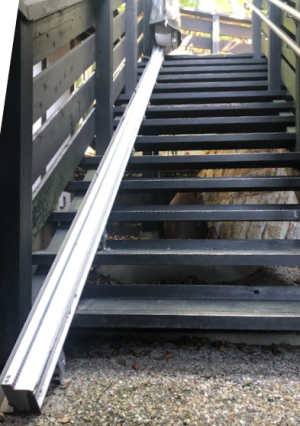 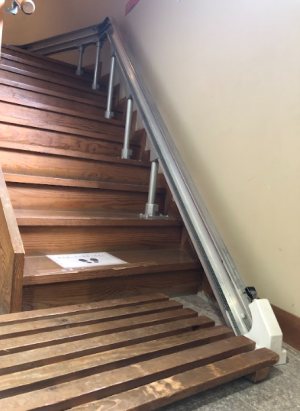 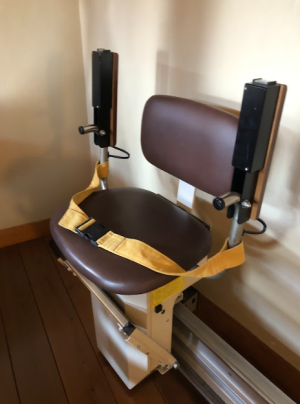 |
| キャッシュレス決済 Cashless payment |
非対応 現金のみ(1万円札不可) Cash only (10,000 yen bills not accepted) |
| 住所 Address |
〒489-0829 愛知県瀬戸市西郷町98 98 Nishigocho, Seto, Aichi |
| 電話 Phone |
0561-89-6001 |
| メール |
sometsuke@gctv.ne.jp |
■交通アクセス/Access
| 電車で By train |
名鉄瀬戸線「尾張瀬戸駅」から徒歩20分 20 minutes walk from Owari Seto Station on the Meitetsu Seto Line |
|---|---|
| 車で By car |
東海環状自動車道「せと赤津IC」から約6分 6 minutes from Tokai Kanjo Expressway "Seto Akazu IC" |
| 駐車場 Parking |
無料(普通車5台) 駐車場に限りがありますのでなるべく公共交通機関でお越しください。 Free (5 regular cars) Parking is limited, so please use public transportation if possible |
カーナビがなぜか狭い道(×印の道)を案内するようですのでご注意を!!!
赤線の広い道路を通っていらしてください。

■施設のご案内/Facility guide
尾張瀬戸駅から東方面へ歩いて約20分、なかなかの坂道を登っていくと途中に見えてくる風変わりな建物が、瀬戸染付工芸館です。瀬戸染付の普及・啓発することを目的に平成12年(2000年)4月15日「瀬戸市マルチメディア伝承工芸館」としてオープンしました。敷地面積は460.39㎡(約140坪)。
About a 20-minute walk east from Owari Seto Station, the Seto Sometsuke Crafts Museum is a peculiar building that comes into view when you climb a steep slope that suddenly appears.
It was opened on April 15, 2000 as the Seto City Multimedia Traditional Crafts Center with the aim of spreading and enlightening about Seto Sometsuke. The site area is 460.39 square meters.


着工前/後のようす Before/after construction
坂道が多い、道幅が狭い、北斜面、平らな場所が少ないなど、瀬戸ではどこでも見られる風景の中にあり、板壁と土壁をドッキングさせたユニークな外観は「愛知まちなみ建築賞」を受賞したことがあります。
It is located in a landscape that can be seen anywhere in Seto, such as many slopes, narrow roads, north slopes, and few flat areas. The unique appearance of docking wooden walls and earthen walls won the "Aichi Townscape Architecture Award" have done.
その後平成26年(2014年)に「瀬戸染付工芸館」へと名称変更し、現在も瀬戸染付の普及・啓発を行っています。
After that, in 2014, the name was changed to "Seto Sometsuke Blue and White Ceramics Center" and even now, we are promoting and enlightening Seto Sometsuke.
敷地内には3つの展示館があり、本館・交流館・古窯館に分かれています。
There are three exhibition halls on the premises, divided into the main hall, exchange hall, and old kiln house.
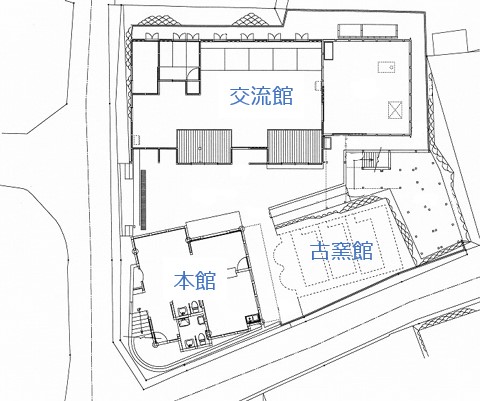
| 本館 Main hall |
|
|
|
|
| ・修了生の寄贈作品展示 ・書籍の閲覧 ・絵付けスペース ・予約制「染付体験教室」の会場 [2nd floor] ・Exhibition of works donated by graduates ・Browsing books ・Painting space ・Venue for“Sometsuke Experience Class”(reservation required) |
| 交流館 Excange hall |
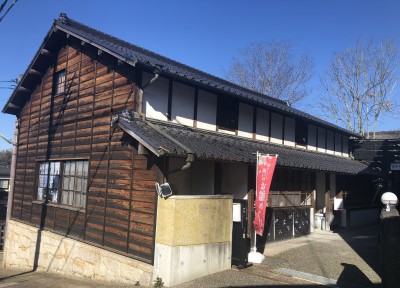 本館向かいにある建物は、もともとこの地にあり、江戸時代から代々古陶園(ことうえん)を号した染付窯屋である伊藤伊平家の細工場を復元した建物です。 本館向かいにある建物は、もともとこの地にあり、江戸時代から代々古陶園(ことうえん)を号した染付窯屋である伊藤伊平家の細工場を復元した建物です。木造2階建て、延べ床面積227.74㎡(約69坪)。 The building across from the main building was originally located in this area, and is a restored small factory of the Ito Ihei family, a dyeing kiln that has been called Kotoen for generations since the Edo period. Two-story wooden building with a total floor area of 227.74㎡. 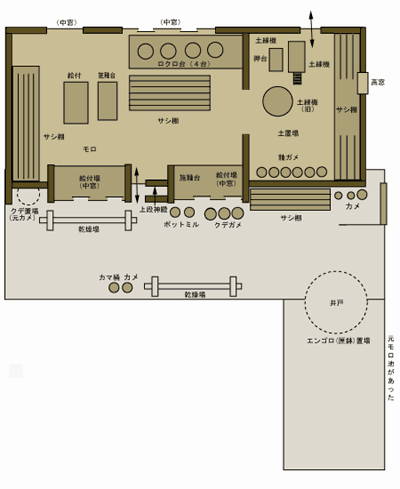 伊藤伊平家モロ 復元前の平面図▶ Ihei Ito's House Moro Floor Plan Before Restoration▶ 瀬戸ではこのような細工場のことを「モロ」(室)と呼んでいます。 温度や湿度などの急激な変化を嫌うやきもの制作のために工夫された建物となっています。 伝統的な瀬戸の工房(モロ)は珪藻土と板張りでできています。 1階南側は絵付け等の作業をするためにできるだけガラス窓を設け、北側はほとんど窓もないところでの作業であったそうです。復元された建物は可能な限り伝統的な工法が取り入れられています。 In Seto, small factories like this are called “moro” (rooms). It is a building devised for the production of pottery that does not like sudden changes in temperature and humidity. A traditional Seto workshop (moro) is made of diatomaceous earth and planks. Glass windows were installed as much as possible on the south side of the first floor for work such as painting, and work was done in a place with almost no windows on the north side. The restored buildings have used traditional construction methods wherever possible. |
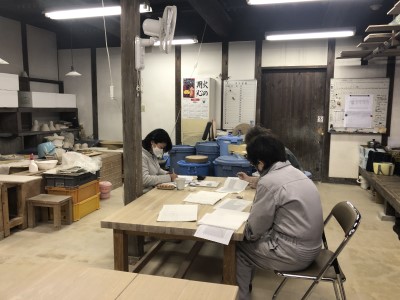 【1F】研修生の工房/Trainee workshop 【1F】研修生の工房/Trainee workshop 染付の技術保存・継承の為の人材育成を目的として研修生受け入れを行っています。 研修は自己課題による作陶活動を基本とし、指導員のもとで各自研鑽を積んでいます。 We are accepting trainees for the purpose of human resource development for the preservation and succession of sometsuke techniques. The training is based on pottery-making activities based on self-assignment, and each student works hard under the guidance of an instructor. 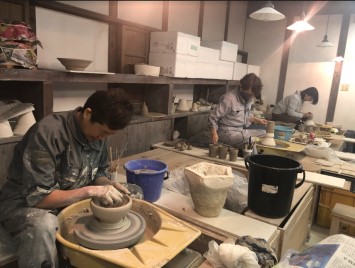 染付(絵付け)だけでなく、土をこね、成形し、焼成し、完成まですべての工程を学びます。 You will learn not only dyeing (painting), but also all the processes from kneading the clay, shaping it, firing it, and completing it. 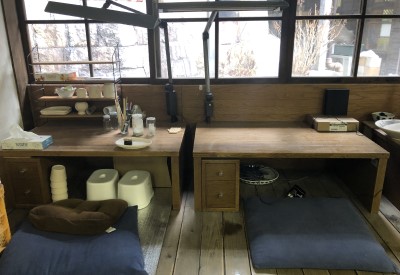 作業の様子は開放されていて、ロクロや絵付けの様子を自由にご見学いただけます。 The work is open to the public, and you can freely observe the potter's wheel and painting. 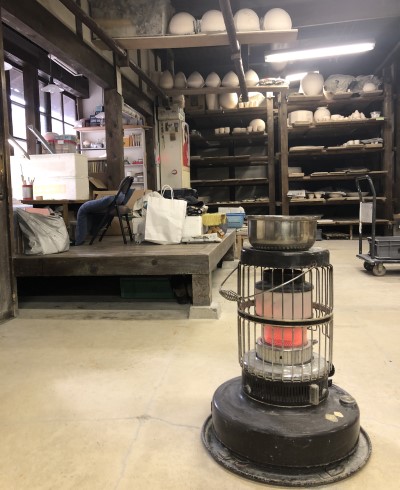 ※研修生希望者は「募集要項」をご覧ください *If you are interested in becoming a trainee, please see the application guidelines. |
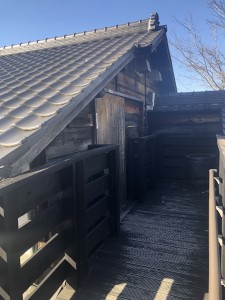 【2F】企画展Special exhibition display 【2F】企画展Special exhibition display期ごとに企画展を開催し、幕末期から明治期にかけての伝統的な瀬戸染付の作品をご覧いただけます。 Special exhibitions are held each period, and you can see traditional Seto dyeing works from the end of the Edo period to the Meiji period. 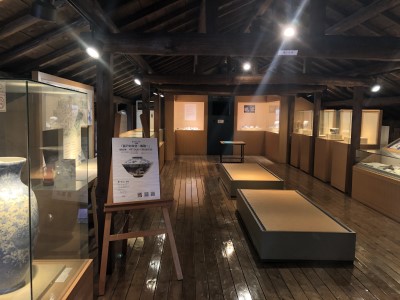 ※現在開催中の企画展はこちら ※現在開催中の企画展はこちら* Click here for current exhibitions また、瀬戸染付の製作工程や道具の展示、染付の歴史を映像で紹介しています。 In addition, the production process of Seto Sometsuke, the exhibition of tools, and the history of Sometsuke are introduced through videos. |
| 古窯館 Old Kiln house |
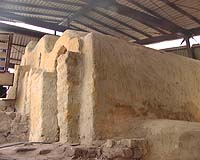 古窯(こがま)とは本業窯(ほんぎょうがま)・丸窯(まるがま)とともに近代に活躍した登り窯の一種です。 古窯(こがま)とは本業窯(ほんぎょうがま)・丸窯(まるがま)とともに近代に活躍した登り窯の一種です。Kogama is a type of climbing kiln that has been active in modern times, along with Hongyogama and Marugama. 本業窯が陶器を焼成、 丸窯が大型磁器を焼成したのに対し、 古窯は陶器と磁器を併焼していました。 A professional kiln fires pottery, While the round kiln fired large porcelain, Old kilns co-fired pottery and porcelain. 構造は他の登り窯に比べて、小型で急勾配となっています。 当館の古窯は、主に小型の磁器製品を焼成していました。 The structure is smaller and steeper than other climbing kilns. The museum's old kilns were mainly used to fire small porcelain products. もとは江戸後期から続く染付磁器の名門窯元【古陶園竹鳳窯】(ことうえん ちくほうがま)として現在地より南の経塚山(現在の弘法山)にありましたが、昭和22年に移築、昭和39年まで使用されていました。 瀬戸市で唯一残された古窯なので、平成9年(1997年)に瀬戸市指定文化財に指定され、また平成19年には経済産業省より「近代文化産業遺跡群」に認定されました。完全な形で残されている最後の古窯です。 It was originally located on Mt. Kyozuka (currently Mt. Kobo) south of the current location as Chikuhogama, a prestigious dyed porcelain ware that has continued since the late Edo period. was used. As it is the only old kiln remaining in Seto City, it was designated as a Cultural Property by Seto City in 1997, and in 2007 by the Ministry of Economy, Trade and Industry. . It is the last old kiln left in perfect shape. 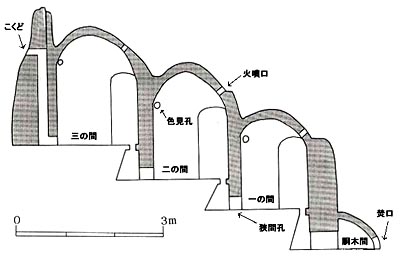 There are rooms 1, 2, and 3 in order from the fire opening, and there are fire blowing holes and color holes at key points. 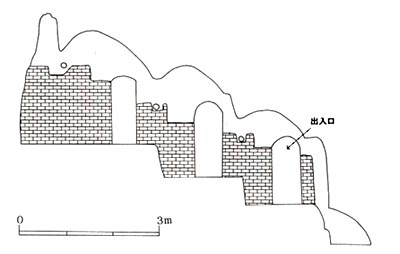 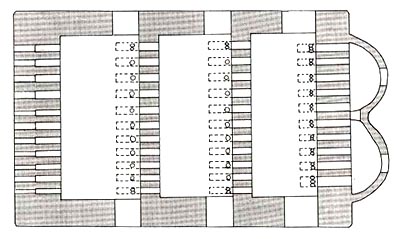 |
■学校団体・一般団体の方へ
社会科・総合学習の時間・地域学習などの様々な場面にご活用ください。電話予約にてお申し込みください。
A.自由見学
館内を自由にご見学ください。
B.同行説明※要予約
職員が展示室や工房のポイントを解説しながらご案内します。
1グループ20名まで、15~20分程度。
« TOPへ戻る
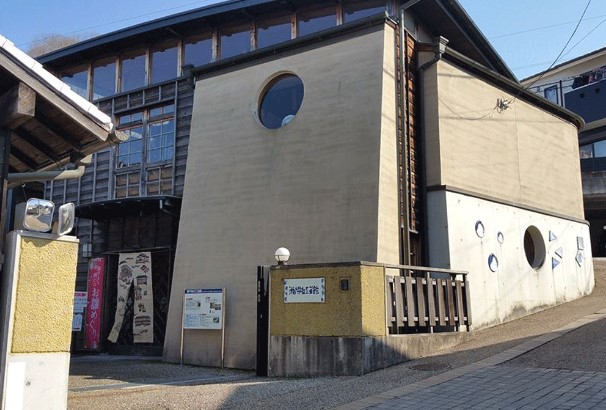 本館は木造2階建て、延べ床面積138.34㎡(約42坪)
本館は木造2階建て、延べ床面積138.34㎡(約42坪)